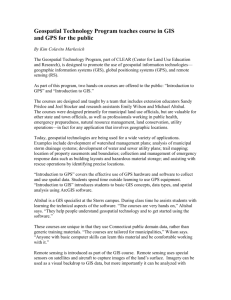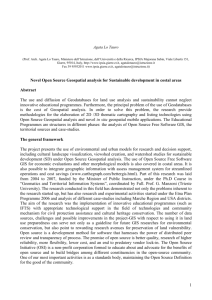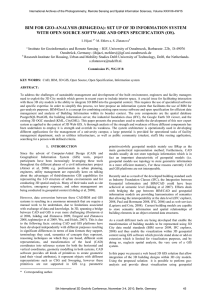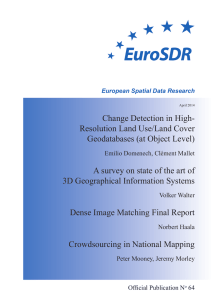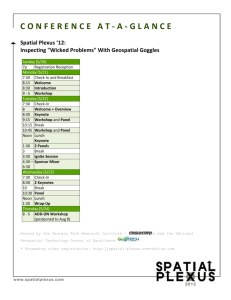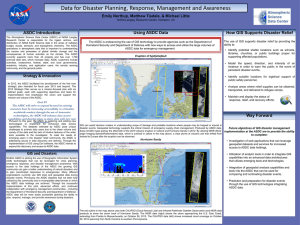Chen_2010 - West Virginia GIS Technical Center
advertisement
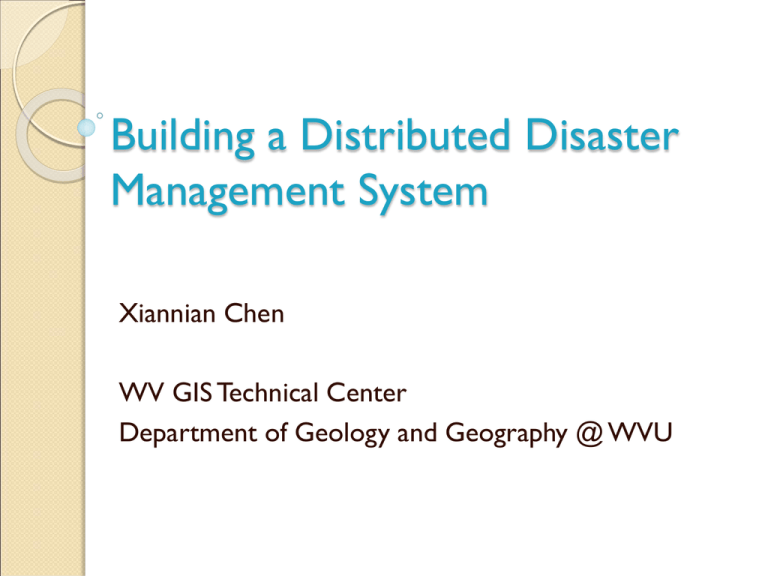
Building a Distributed Disaster Management System Xiannian Chen WV GIS Technical Center Department of Geology and Geography @ WVU Disasters Yangzi River Floods (China, 1998.14 million people homeless) 911 Terrorist Attack (USA, 2001. About 3000 people killed) Indonesian Tsunami (2004. About 230,000 people killed) Hurricane Katrina (USA, 2006. At least 1,836 people killed) Wenchuan 512 Earthquake (China, 2008.70, 000 people killed and 5 million people homeless) Haiti Earthquake (Haiti, 2010. About 230,000 people killed and 1million people homeless) Characteristics of Disasters Large scale, which means two or more jurisdictions will be involved. Rapid onset, which means the events give people no time or short time to prepare to evacuate. Dynamic, which means disasters evolve as they progress. Disaster Management Phases Four phases overlaid in a continuous cycle. ◦ Response Rescue Relief ◦ Recovery ◦ Mitigation ◦ Preparedness Needs in Disaster Management The need for efficient and effective access to decision-making information relevant to all phases of emergency management; The need for collaboration among the agencies at different levels; The need for the collaboration of different agencies that are in charge of different thematic data. Challenges that traditional GIS faces Built on stand-alone platform. Hard to communicate among systems. Users at one end of internet/intranet cannot share information with users at the other end. ◦ e.g. The in-house GIS system/model cannot accept the dynamic input from the in-field first-time responders. Managers in the emergency operation center cannot make the right decisions without real-time information. How Distributed GIS overcome the challenges? As the integration of geospatial data, geospatial tool, and distributed computing technologies, distributed GIS computing can overcome the challenges, such as realtime data collection and updating, realtime information dissemination, distributed information access, distributed processing services access. Distributed GIS System Distributed GIS is geospatial technologies combined with distributed computing technologies and the standards of Internet. Internet GIS ◦ Internet refers to the network infrastructure. ◦ Web-based GIS is one kind of Internet GIS Based on HTTP protocol, which is one of many applications that runs on Internet Mobile GIS ◦ Wireless GIS The core of Distributed GIS is geospatial web service Geospatial Web Services SOAP (Simple Object Access Protocol) web service, based on Service Oriented Architecture (SOA) HTTP (HyperText Transport Protocol) web service, based REST Oriented Architecture (ROA) OGC’s SOAP Web Service OGC: Open Geospatial Consortium Data sharing web services. ◦ Web Map Service (WMS) ◦ Web Feature Service (WFS) Processing sharing web services ◦ Web Processing Services (WPS) REST Web Services REST (Representational State Transfer) Roy Fielding in 2000. Basically means that each unique URL is a representation of some object. Get the contents of that object by using an HTTP GET. Use a POST, PUT, or DELETE to modify the object. REST Web Services Characteristics Client-Server Stateless: each request from client to server must contain all the information necessary to understand the request. Cache: to improve network efficiency, responses must be capable of being labeled as cacheable or non-cacheable. Uniform interface: all resources are accessed with a generic interface (e.g., HTTP GET, POST, PUT, DELETE). Named resources - the system is comprised of resources which are named using a URL. Interconnected resource representations: the representations of the resources are interconnected using URLs Layered components: intermediaries can be inserted between clients and resources to support performance, security, etc. REST vs. SOAP REST over SOAP: ◦ Lightweight – not a lot of extra xml markup ◦ Human Readable Results ◦ Easy to build – no toolkits required REST is the trend in web service. ◦ “Use SOAP to wash, and you REST when you are tired.” ◦ All of the major web services on the Internet now use REST: Twitter,Yahoo’s web services, Flickr, and so on. Types of REST Web Services Types of REST services ◦ REST data services Image services Map services Geodata services Geocoding services Geometry service ◦ REST geoprocessing services Geoprocessing services REST Data Services Purpose: ◦ Data collection, updates, dissemination, and access Data collection and updates ◦ GPS for thematic vector data ◦ Improved Remote Sensing for basemap and imagery Data dissemination and data access ◦ Map Cache Provides fast access to cached image or map service ◦ Optimized map service Provides fast access to vector data REST Geoprocessing Services Purpose ◦ Provides Internet access to sophisticated GIS Desktop functionalities, such as functionalities in spatial analyses, functionalities 3D analyses, functionalities network analyses, and the combinations of functions in those extensions. Features of Distributed Disaster Management System Easier dynamic (real-time) data sharing Faster map rendering Rich desktop GIS functionalities integrated Questions and comments?






